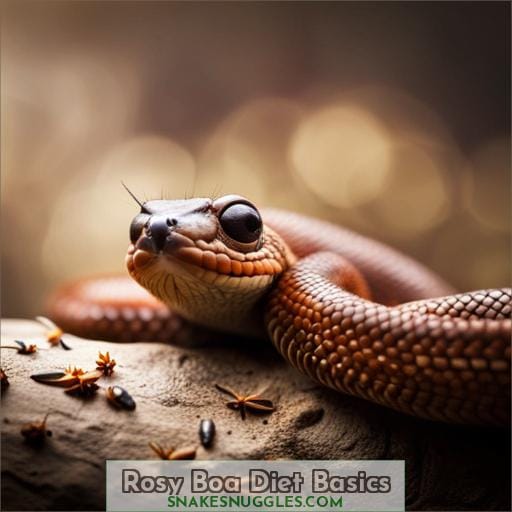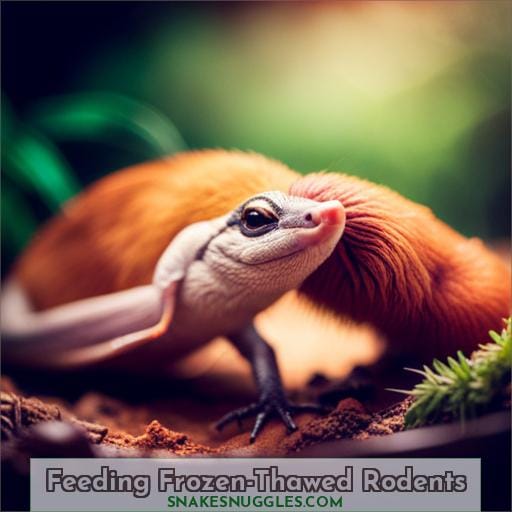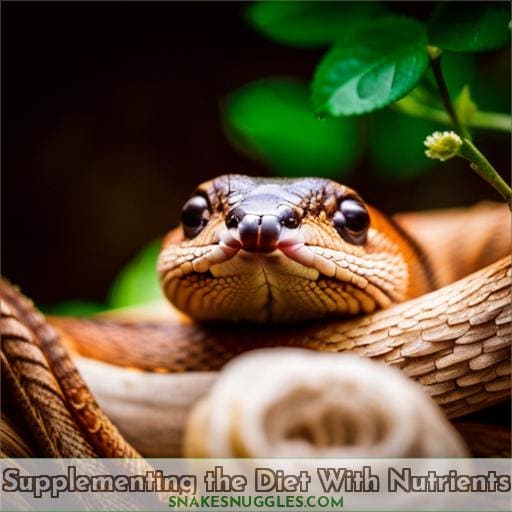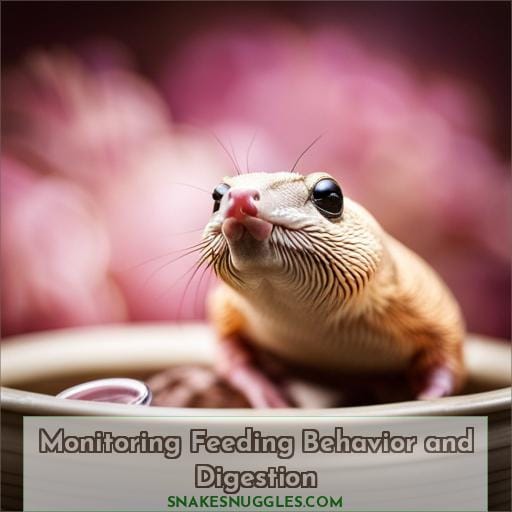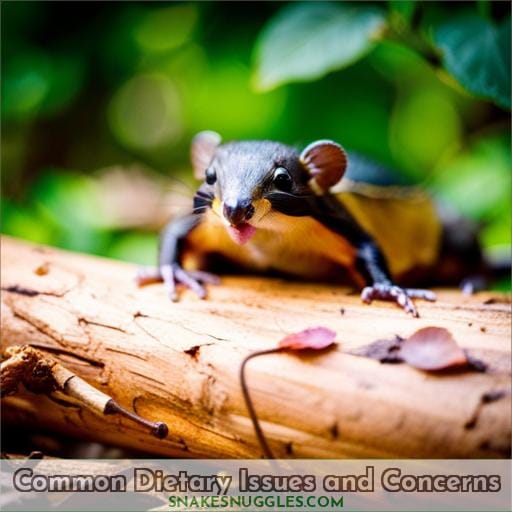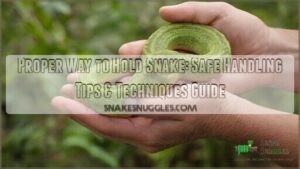This site is supported by our readers. We may earn a commission, at no cost to you, if you purchase through links.
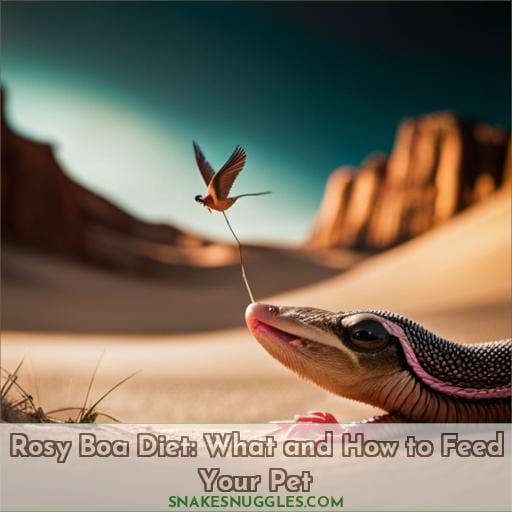 Discover the secrets to providing a nutritious and balanced diet for your rosy boa.
Discover the secrets to providing a nutritious and balanced diet for your rosy boa.
Learn what prey items are suitable, how often to feed them, and the proper food size for optimal health.
Find out about the benefits of feeding frozen-thawed rodents and how to properly thaw and warm them before offering them as a meal.
With this comprehensive guide on rosy boa diet, you’ll have all the knowledge you need to keep your pet snake healthy and thriving.
Table Of Contents
- Key Takeaways
- Rosy Boa Diet Basics
- Feeding Frozen-Thawed Rodents
- Choosing the Right Prey Size for Your Rosy Boa
- Supplementing the Diet With Nutrients
- Monitoring Feeding Behavior and Digestion
- Common Dietary Issues and Concerns
- Seeking Veterinary Care for Dietary Issues
- Frequently Asked Questions (FAQs)
- Conclusion
Key Takeaways
- Choose between live or frozen prey options for feeding your rosy boa, weighing the benefits and risks.
- Feed rosy boas two to four times per month, adjusting the frequency based on age and size.
- Provide prey items that are approximately the same width as the widest point of your rosy boa, adjusting as it grows.
- Supplement the diet with calcium, vitamin D3, and multivitamins to ensure proper nutrition.
Rosy Boa Diet Basics
When it comes to the diet of a Rosy Boa, there are three important factors to consider:
- Prey items
- Feeding frequency
- Proper food size
Rosy Boas primarily eat live mice and should be fed two to four times per month.
It’s crucial to provide prey items that are approximately the same width as the widest point of your snake for easy swallowing and digestion.
Prey Items
To properly feed your Rosy Boa, you need to understand the basics of their prey items.
Live prey offers benefits such as stimulating natural hunting instincts and providing mental enrichment.
However, live prey also carries risks such as injury to your snake during feeding.
Frozen prey is a safer alternative that still provides essential nutrients for your Rosy Boa’s diet.
Make sure to weigh the benefits and risks when choosing between live or frozen options for feeding your pet snake.
Feeding Frequency
You should feed your Rosy Boa two to four times per month.
The feeding frequency is an important aspect of their diet to ensure proper nutrition and maintain their overall health.
Here are some guidelines for the feeding frequency:
- Feed young Rosy Boas (2-3 months old) every 7-10 days.
- Adult Rosy Boas can be fed once every 2 weeks or even once a month.
- Avoid overfeeding, as it can lead to obesity and digestive problems.
Maintaining a consistent feeding schedule will help keep your Rosy Boa healthy and thriving.
Proper Food Size
When determining the proper food size for your Rosy Boa, consider the size and age of your snake as well as its feeding response. It’s important to provide prey items that are appropriate in size to ensure proper digestion and minimize the risk of choking or regurgitation.
Here is a handy prey size chart to help you determine the right prey item for your Rosy Boa based on its length:
| Snake Length | Prey Size |
|---|---|
| 10-20 inches | Pinkie |
| 20-30 inches | Fuzzy |
| 30+ inches | Adult Mice |
Feeding Frozen-Thawed Rodents
When feeding your Rosy Boa frozen-thawed rodents, there are several benefits to consider.
- Frozen-thawed prey is safer and more convenient than live prey, as it eliminates the risk of injury or disease transmission.
- To properly thaw and warm the prey, you can use methods such as placing it in a baggie in warm water or using a reptile-specific warming device.
- Once thawed and warmed, offer the rodent to your Rosy Boa using tongs for safety and control during feeding time.
Benefits of Frozen-Thawed Prey
Feeding your Rosy Boa frozen-thawed rodents offers numerous benefits for both the health of your snake and ease of feeding.
Prevents bacteria growth: Frozen rodents eliminate the risk of bacterial contamination that live prey may carry.
More nutritious: Freezing preserves the nutrients in the prey, ensuring a well-balanced diet for your boa.
Less chance of parasites: Frozen-thawed prey reduces the risk of introducing parasites to your snake.
Easier to store and more affordable: Buying frozen rodents in bulk allows for convenient storage and cost savings compared to purchasing live prey regularly.
How to Thaw and Warm the Prey
Thawing and warming the prey for your Rosy Boa involves ensuring it reaches an appropriate temperature before offering it to your snake.
To safely thaw frozen rodents, you have a few options.
One method is to place the prey in a microwave-safe container and use short intervals of low heat until defrosted.
Alternatively, you can thaw overnight in the fridge or under running water.
Another option is using a hair dryer on low heat, keeping it at a safe distance from the food to avoid overheating or cooking it.
Offering the Prey to Your Rosy Boa
To offer the prey to your Rosy Boa, simply dangle the thawed and warmed frozen rodent in front of them using a pair of tongs or forceps.
Approach your Rosy Boa’s enclosure calmly and confidently.
Gently bring the prey close to their open mouth, mimicking natural movement to trigger their hunting instincts.
Be patient as they may strike quickly or take some time before striking.
Once caught, they’ll hold onto the prey tightly with their teeth and coils until ready to swallow it whole for digestion.
Choosing the Right Prey Size for Your Rosy Boa
When it comes to choosing the right prey size for your Rosy Boa, there are a few factors to consider.
First, you need to determine the size of your snake and match it with an appropriate prey item. A general rule of thumb is to provide prey that’s approximately the same width as the widest point of your Rosy Boa.
Feeding Schedule for Your Rosy Boa
How Often Should You Feed Your Rosy Boa?
Tips for Feeding Your Rosy Boa
Determining the Size of Your Rosy Boa
Are you unsure about how to determine the right prey size for your Rosy Boa? Here are three key factors to consider when choosing the right prey size:
- Widest point of the snake:
- Measure the widest part of your Rosy Boa’s body, usually around its midsection or thickest area.
- Head shape and width:
- Take into account the width and shape of your snake’s head, as it needs to be able to comfortably swallow its food.
- Age and growth rate:
- Consider your Rosy Boa’s age and growth stage. Younger snakes will require smaller prey items compared to adults.
By considering these factors, you can ensure that you’re offering appropriately sized meals for optimal nutrition and digestion for your pet snake.
Prey Size Guidelines
Choose the appropriate prey size for your Rosy Boa based on its age and size.
When it comes to feeding your snake, you want to ensure that the prey isn’t too small or too large.
For hatchlings and young juveniles, start with pinky mice or hopper mice.
As your Rosy Boa grows, gradually increase the size of the prey to adult mice, rat pups, or even quail chicks if available.
Adjusting the prey size accordingly ensures proper nutrition and prevents any potential digestive issues for your pet snake in its enclosure.
Adjusting Prey Size as Your Rosy Boa Grows
As your Rosy Boa grows, you’ll need to adjust the prey size to ensure proper feeding and growth.
- Monitor the growth rate of your snake to determine when it’s time for a larger prey size.
- Gradually increase the size of the prey items as your Rosy Boa gets bigger.
- Avoid offering prey that’s too large, as this can lead to regurgitation and digestive issues.
Supplementing the Diet With Nutrients
To ensure your rosy boa receives all the necessary nutrients, it’s important to supplement their diet.
Calcium and vitamin D3 are crucial for bone health and can be provided through dusting prey items with a calcium powder that contains vitamin D3.
Additionally, multivitamin supplements should be given to provide a balanced array of vitamins and minerals.
The frequency and method of supplementation will depend on the age, size, and specific needs of your rosy boa.
Calcium and Vitamin D3
To ensure your Rosy Boa receives adequate nutrition, it’s important to supplement their diet with calcium and vitamin D3. Calcium is essential for strong bones and proper muscle function, while vitamin D3 helps the body absorb calcium.
Without sufficient levels of these nutrients, your snake may develop health issues such as calcium deficiency or vitamin D3 deficiency. It’s crucial to provide a balanced diet along with appropriate supplements to maintain optimal calcium and vitamin D3 levels in your pet.
| Nutrient | Function | Sources |
|---|---|---|
| Calcium | Bone strength, muscle function | Cuttlebone |
, eggshells
, reptile-specific
bone meal
, dietary insectsVitamin D₃ Absorption of Sunlight exposure,
(Cholecalciferol) liver oil,
fortified foods
Multivitamin Supplements
When supplementing the diet of your Rosy Boa with nutrients, it’s important to consider using multivitamin supplements. These supplements provide a range of essential vitamins and minerals that may be lacking in their diet.
Here are three key considerations when using multivitamin supplements for your Rosy Boa:
- Types: Look for reptile-specific multivitamins formulated specifically for snakes.
- Dosage: Follow the recommended dosage instructions provided by the manufacturer.
- Frequency: Administer multivitamin supplements according to the guidelines provided on the packaging or as advised by a reptile veterinarian.
In this subtopic, we’ll explore how supplementing your Rosy Boa’s diet with nutrients can be achieved through the use of multivitamin supplements. Multivitamins are an excellent way to ensure that your snake is receiving all necessary vitamins and minerals not readily available in their prey items alone.
Firstly, it’s crucial to select a suitable type of multi-vitamin supplement designed explicitly for reptiles like snakes such as rosy boas. This ensures that they contain appropriate levels and forms of essential nutrients needed by these animals.
Secondly, dosages should always follow manufacturers’ recommendations found on product labels. To avoid potential health risks associated with over-supplementation or vitamin toxicity, it is vital not exceed recommended doses without consulting a qualified herpetologist, veterinarian ,or other experts knowledgeable about nutritional needs of specific species.
Lastly, frequency of administration depends upon factors including age, size, dietary habits, and general health condition. In general, a schedule consisting of regular intervals (e.g., weekly, bimonthly) is commonly employed.
However, every individual may differ slightly due to individual variations in metabolism. It is best to consult professionals to establish optimal frequency of supplementation based on the unique characteristics of your pet rosy boa.
By incorporating these considerations into your feeding routine, you can effectively enhance nutrition intake and overall well-being of your pet. Multivitamin provides additional insurance against any nutritional deficiencies that may arise from a limited diet of captive rosy boas.
These supplements can help support proper growth, development, and overall health of your reptilian companion. However, it’s essential to be mindful of potential risks of over-supplementation or incorrect dosing.
Therefore, following instructions provided by manufacturers and seeking guidance from professionals is vital to ensure safe and effective use of multivitamin supplementation.
Frequency and Method of Supplementation
You should regularly supplement your Rosy Boa’s diet with nutrients by using a multivitamin at least once a month. This ensures that your snake receives the essential vitamins and minerals it needs for optimal health.
When supplementing, you can use a method called dusting, where you lightly coat the prey item with the multivitamin powder before feeding it to your boa.
The recommended amount of vitamin D3 in the form of calcium carbonate is 100-200 IU per gram of food offered.
Monitoring Feeding Behavior and Digestion
When it comes to monitoring your rosy boa’s feeding behavior and digestion, there are a few key points to keep in mind.
First, you should observe signs of hunger and appetite, such as increased activity or searching for food.
Second, it’s important to pay attention to proper digestion by ensuring that your snake passes stools regularly and without any signs of constipation or diarrhea.
Lastly, be prepared to adjust the feeding schedule as needed based on your rosy boa’s individual needs and growth rate.
Signs of Hunger and Appetite
As you continue to monitor the feeding behavior and digestion of your rosy boa, it’s important to be aware of the signs that indicate hunger and appetite.
Keep an eye out for:
- A sunken belly
- Slow movement
- Glassy eyes
- Wrinkled skin
- Decreased activity
These are potential indicators that your snake may be hungry or lacking in appetite. Paying attention to these cues will help ensure that your pet receives proper nourishment and stays healthy.
Observing Proper Digestion
To ensure the health and well-being of your Rosy Boa, it’s important to observe proper digestion after each feeding.
- Normal stool color
- Normal stool shape
- Normal stool size
- Normal stool frequency
- Normal stool consistency
By monitoring these factors, you can assess if your Rosy Boa is digesting its food properly and maintaining a healthy gastrointestinal system.
Adjusting Feeding Schedule as Needed
Monitoring the feeding behavior and digestion of your Rosy Boa is essential for adjusting their feeding schedule as needed.
Pay attention to:
- How often they eat
- Their growth rate
- Prey availability
Health concerns such as obesity or malnutrition can arise if the feeding frequency isn’t properly adjusted. Additionally, seasonal changes may affect your boa’s appetite and metabolism. By closely observing these factors, you can ensure that your Rosy Boa receives a balanced diet for optimal health and wellbeing.
Common Dietary Issues and Concerns
When it comes to feeding your rosy boa, there are a few common dietary issues and concerns that you should be aware of:
- One issue is the refusal to eat, which can occur for various reasons such as stress or illness.
- Overfeeding and obesity is another concern, as it can lead to health problems in your snake.
- Lastly, regurgitation and digestive problems may occur if the snake has been fed inappropriate prey items or if there are underlying health issues.
It’s important to monitor your rosy boa’s eating habits closely and address any concerns with proper care and veterinary attention if needed.
Refusal to Eat
If your Rosy Boa is refusing to eat, it can be a common dietary issue that pet owners may encounter.
- Dehydration: Lack of water intake can decrease appetite in snakes.
- Stress: Environmental changes or handling can cause stress and lead to loss of appetite.
- Illness or parasites: Underlying health issues or parasite infestations can affect the snake’s ability to eat.
It is important to identify and address the underlying cause of refusal to eat in order to ensure the well-being of your Rosy Boa.
Overfeeding and Obesity
Avoid overfeeding your Rosy Boa to prevent obesity and related health issues.
While it may be tempting to give your snake extra food, overfeeding can lead to weight gain and various health problems.
Obesity in snakes can cause:
- Decreased mobility
- Organ strain
- Respiratory difficulties
- A shortened lifespan
Signs of obesity include:
- A bulging belly
- Difficulty moving
- Curled into tight loops when resting
To prevent obesity in your Rosy Boa, feed them an appropriate diet based on their size and monitor their body condition closely.
Regurgitation and Digestive Problems
Are you experiencing regurgitation or digestive problems with your Rosy Boa after feeding? These issues can be concerning, but understanding the causes and symptoms can help you address them effectively.
Regurgitation in Rosy Boas is often caused by improper handling during or after feeding, while digestive problems may arise from dietary imbalances or infections.
If your snake exhibits these issues, it’s important to seek veterinary care for proper diagnosis and treatment options to ensure a positive prognosis.
Preventative measures like proper handling techniques and balanced diets are key in avoiding these concerns altogether.
Seeking Veterinary Care for Dietary Issues
If you notice any signs of illness or nutritional deficiencies in your rosy boa, it’s important to seek veterinary care.
A reptile veterinarian will be able to properly diagnose the issue and provide appropriate treatment options.
By addressing dietary issues promptly with professional help, you can ensure the health and well-being of your pet rosy boa.
Signs of Illness or Nutritional Deficiencies
If you notice any signs of illness or nutritional deficiencies in your Rosy Boa, it’s important to seek veterinary care for dietary issues.
Some common signs to watch out for include:
- Dull skin
- Weight loss
- Sunken eyes
- Lethargy
- Abnormal stool
These symptoms can indicate that your snake isn’t getting the proper nutrients it needs from its diet.
A veterinarian specializing in reptiles will be able to diagnose the issue and provide appropriate treatment options.
Consulting a Reptile Veterinarian
If you notice any signs of illness or nutritional deficiencies in your Rosy Boa, it’s important to consult a reptile veterinarian as soon as possible.
When to see a vet:
- Persistent loss of appetite
- Abnormal weight loss or gain
- Digestive issues like regurgitation or diarrhea
What to expect at the vet:
- Thorough examination and assessment
- Diagnostic tests if necessary (bloodwork, x-rays)
Costs of vet visits can vary but be prepared for expenses.
Finding a reptile vet:
Ask for recommendations from other reptile owners or search online directories.
Emergency Vet Care:
Have contact information ready in case of emergencies.
Proper Diagnosis and Treatment Options
To ensure the health and well-being of your rosy boa, it’s important to seek veterinary care if you notice any dietary issues or concerns.
Some common problems that may arise include:
- Dehydration
- Impaction
- Anorexia
- Regurgitation
- Malnutrition
Dehydration symptoms can include:
- Dry skin
- Sunken eyes
Impaction symptoms may manifest as:
- Constipation
- Lack of bowel movements
Causes of anorexia can range from:
- Stress
- Illness
Regurgitation can occur due to:
- Improper feeding techniques
- Underlying health conditions
Signs of malnutrition include:
- Weight loss
- Poor body condition
Frequently Asked Questions (FAQs)
Can I feed my Rosy Boa live prey instead of frozen-thawed rodents?
Feeding your Rosy Boa live prey instead of frozen-thawed rodents isn’t recommended.
Frozen-thawed rodents are safer and more convenient, as they eliminate the risk of injury to both your snake and the prey.
How often should I feed my Rosy Boa?
To ensure the health and well-being of your Rosy Boa, it’s recommended to feed them every two weeks. This regular feeding schedule provides them with the necessary nutrition while promoting their overall vitality and longevity.
What should I do if my Rosy Boa refuses to eat?
If your Rosy Boa refuses to eat, there are a few things you can try:
- Check the temperature and humidity levels in the enclosure.
- Ensure proper hiding spots are available.
- Consider offering different types of prey.
- Use feeding techniques like scenting or braining.
Can I feed my Rosy Boa other types of food besides rodents?
No, it isn’t recommended to feed your Rosy Boa other types of food besides rodents.
Their natural diet consists of small mammals and birds, so offering them live or frozen-thawed mice or rats is the best choice for their nutritional needs.
How do I know if my Rosy Boa is getting the right amount of nutrients in its diet?
To ensure your Rosy Boa is getting the right nutrients, observe its body condition and behavior.
A healthy boa will have:
- A well-rounded body
- Clear eyes
- Active movement
Regular veterinary check-ups can also help monitor their overall health and diet adequacy.
Conclusion
To ensure the health and well-being of your rosy boa, it’s crucial to provide a proper diet.
By following the guidelines for rosy boa diet, including selecting suitable prey items, feeding frequency, and prey size, you can help your snake thrive.
Feeding frozen-thawed rodents offers numerous benefits, and it’s important to correctly thaw and warm the prey before offering it to your rosy boa.
Additionally, monitoring feeding behavior and digestion, addressing dietary issues, and seeking veterinary care when necessary are key for maintaining your pet’s nutritional needs.

